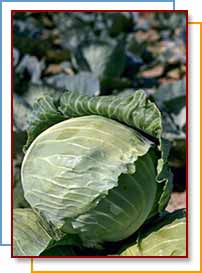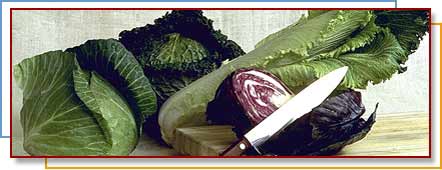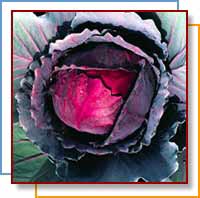
Cabbage, one of the oldest vegetables, continues to be a dietary staple and an
inexpensive food. It is easy to grow, tolerates the cold, and keeps well.
Cabbage is an excellent source of Vitamin C.
 Look for solid, heavy heads of cabbage. Avoid cabbage that has
discolored veins or worm damage. Do not buy precut cabbage, the leaves may
have already lost their vitamin C. Look for stems that are healthy
looking, closely trimmed, and are not dry or split. Look for solid, heavy heads of cabbage. Avoid cabbage that has
discolored veins or worm damage. Do not buy precut cabbage, the leaves may
have already lost their vitamin C. Look for stems that are healthy
looking, closely trimmed, and are not dry or split.
Keep cabbage cold. This helps it retain its vitamin C content. Place
the whole head of cabbage in a plastic bag and store in the refrigerator.
Once the head has been cut, place the remainder in plastic bags and place
in the refrigerator. Try to use the remaining cabbage in the next day or
two.
Do not wash cabbage until you are ready to use it. Avoid slicing or
shredding cabbage in advance. This will cause it to lose some of its
vitamin C content. If you must prepare it an hour or more in advance
before cooking, place it in a plastic bag, seal tightly, and refrigerate.
There are at least a hundred different types of cabbage grown
throughout the world, but the most common types in the United States are
the Green, Red, and Savoy varieties. Chinese varieties are also available.
The two most common types of Chinese cabbage are Bok Choy and Napa
cabbage. Chinese cabbage cooks in less time than standard U.S. types, but
can be prepared in the same ways. Cabbage can be steamed, boiled, braised,
microwaved, stuffed, or stir-fried.
|
|
Cooked Cabbage |
Serving size
1/2 cup (75g)
|
Amounts
Per Serving |
% Daily
Value |
| Calories
15 |
|
| Calories
from Fat 5 |
0 |
| Total Fat 0g |
0% |
| Saturated
Fat 0g |
0% |
| Cholesterol
0mg |
0% |
| Sodium
5mg |
0% |
| Total
Carbohydrate 3g |
1% |
|
Dietary Fiber -g |
-% |
|
Sugars -g |
|
| Protein 1g |
|
| Vitamin A |
2% |
| Vitamin C |
25% |
| Calcium |
2% |
| Iron |
0% |
* Percent Daily Values are based on a
2,000 calorie diet.
|
|
| |
|
|
|
|
Raw Cabbage |
Serving size
1/2 cup (35g)
|
Amounts
Per Serving |
% Daily
Value |
| Calories
10 |
|
| Calories
from Fat 0 |
0 |
| Total Fat 0g |
0% |
| Saturated
Fat 0g |
0% |
| Cholesterol
0mg |
0% |
| Sodium
5mg |
0% |
| Total
Carbohydrate 2g |
1% |
|
Dietary Fiber 1g |
4% |
|
Sugars 1g |
|
| Protein 0g |
|
| Vitamin A |
0% |
| Vitamin C |
30% |
| Calcium |
2% |
| Iron |
2% |
* Percent Daily Values are based on a
2,000 calorie diet.
|
|
| |
|
|

Recipes
 Chutney—Pineapple Slaw Chutney—Pineapple Slaw
Serves 4.
Ingredients
2 Tbsp chutney
1/2 tsp grated orange peel
2 Tbsp fresh orange juice
2 1/2 cups shredded cabbage
1/2 cup shredded carrot
1 cup coarsely fresh pineapple or one 8 oz pineapple tidbits
1/4 cup raisins
In a large bowl, combine chutney, orange peel, and orange juice. Mix
well. Add shredded cabbage and carrot, pineapple, and raisins; toss to
mix. Serve immediately or cover and chill until serving time.
Nutritional analysis per serving: Calories 94.5, Fat 0.5g, Calories
from Fat 4%, Carbohydrate 23.6g, Protein 1.7g, Fiber 3.3g, Sodium 37.4mg.
Find more in our
recipe database!
|



